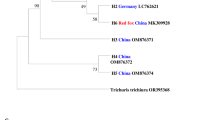Abstract
We have determined the plasma concentrations of copper, zinc, copper/zinc ratio, and carbonic anhydrase activity in horses infected with Babesia equi. The study was conducted in 14 horses with the disease and 10 healthy animals that served as controls. The infection was confirmed by the clinical manifestations of the disease and by Giemsa staining of thin blood smears showing the parasites inside red blood cells. The horses with piroplasmosis had lower plasma levels of zinc, elevated copper, and increased activity of carbonic anhydrase. Consequently, the copper/zinc ratio was also higher than in the healthy controls.
Similar content being viewed by others
References
de Waal DT (1992) Equine piroplasmosis: a review. Br Vet J 148:6–14
Homer MJ, Aguilar-Delfin A, Telford SR III, Krause PJ, Persing DH (2000) Babesiosis. Clin Microbiol Rev 13(3):451–469
Radostits OM, Gay CC, Blood DC, Hinchcliff KW (2000) Veterinary medicine. A textbook of the diseases of cattle, sheep, pigs, goats and horses, 9th edn. Saunders, Philadelphia, pp 1289–1291
Chaturvedi UC, Shrivastava R, Upreti RK (2004) Viral infections and trace elements: a complex interaction. Curr Sci 87:1536–1554
Lukaski HC (2004) Vitamin and mineral status: effects on physical performance. Nutrition 20(7–8):615–619
Van Weyenbergh J, Santana G, D’Oliveira A Jr, Santos AF Jr, Costa CH, Carvalho EM, Barral A, Barral-Netto M (2004) Zinc/copper imbalance reflects immune dysfunction in human leishmaniasis: an ex vivo and in vitro study. BMC Infect Dis 4:50
Failla ML (2003) Trace elements and host defense: recent advances and continuing challenges. J Nutr 133:1443–1447
Wellinghausen N, Jöchle W, Reuter S, Flegel WA, Grünert A, Kern P (1999) Zinc status in patients with alveolar echinococcosis is related to disease progression. Parasite Immunol 21(5):237–241
Lindskog S, Wislrand PJ (1989) Inhibitors of carbonic anhydrase. In: Sandier M, Smith HJ (eds) Design of enzyme inhibitors as drugs. Oxford University Press, Oxford, pp 698–723
Lindskog S (1997) Structure and mechanism of carbonic anhydrase. Pharmacol Ther 74:1–20
Supuran CT, Scozzafava A, Conway J (2004) Carbonic anhydrase—its inhibitors and activators. CRC, Boca Raton, FL, USA
Greenberg WE, Trusell RR, Clescer LS (1996) Standard methods for the examination of water and wastewater, 60th edn. American Public Health Association, Washington, DC, pp 143–179
Longbottom JE, Martin TD, Edgell KW, Long SE, Plantz MR, Warden BE (1994) Determination of trace elements in water by inductively coupled plasma-mass spectrometry: collaborative study. J AOAC Int 77(4):1004–1023
Maren TA (1960) A simplified micromethod for the determination of carbonic anhydrase and 1+5 inhibitors. J Pharmacol Exp Ther 72:77–87
Underwood EJ (1977) Trace elements in human and animal nutrition. Academic, New York, p 208
Mocchegiani E, Muzzioli M (2000) Therapeutic application of zinc in human immunodeficiency virus against opportunistic infections. J Nutr 130:1424–1431
Baum MK, Shor-Posner G, Campa A (2000) Zinc status in human immunodeficiency virus infection. J Nutr 130:1421–1423
Wirth JJ, Fraker PJ, Kierszenbaum F (1989) Zinc requirement for macrophage function: effect of zinc deficiency on uptake and killing of protozoan parasite. Immunology 68:114–119
Kocyigit A, Erel O, Gurel MS, Avci S, Aktepe N (1998) Alterations of serum selenium, zinc, copper, and iron concentrations and, some related antioxidant enzyme activities in patients with cutaneous leishmaniasis. Biol Trace Elem Res 65(3):271–281
Ece A, Uyamik BS, Iscan A, Ertan P, Yigitoglu MR (1997) Increased serum copper and decreased serum zinc levels in children with iron deficiency anemia. Biol Trace Elem Res 59(1–3):31–39
Gürgöze MK, Olçücü A, Aygün AD, Taskin E, Kiliç M (2006) Serum and hair levels of zinc, selenium, iron, and copper in children with iron-deficiency anemia. Biol Trace Elem Res 111(1–3):23–29
Scott ME, Koski KG (2000) Zinc deficiency impairs immune responses against parasitic nematode infections at intestinal and systemic sites. J Nutr 130:1412S–1420S
Sullivan JL, Ochs HD (1978) Copper deficiency and the immune system. Lancet 2:686
Deger S, Biçek K, Deger Y (2005) The changes in some of biochemical parameters (iron, copper, vitamin C and vitamin E) in infected cattle with theileriosis. YYU Vet Fak Derg 16(1):49–50
Turgut S, Polat A, Inan M, Turgut G, Emmungil G, Bican M, Karakus TY, Genc O (2007) Interaction between anemia and blood levels of iron, zinc, copper, cadmium and lead in children. Indian J Pediatr 74:827–830
Healy J, Tipton K (2007) Ceruloplasmin and what it might do. J Neurol Transm 114(6):777–781
Ambawat HK, Malhotra DV, Kumar S, Dhar S (1999) Erythrocyte associated haemato-biochemical changes in Babesia equi infection experimentally produced in donkeys. Vet Parasitol 85(4):319–324
Mafra D, Cozzolino SMF (2004) Erythrocyte zinc and carbonic anhydrase levels in nondialyzed chronic kidney disease patients. Clin Biochem 37:67–71
Lin CC, Huang JF, Tsai LY, Huang YL (2006) Selenium, iron, copper, and zinc levels and copper-to-zinc ratios in serum of patients at different stages of viral hepatic diseases. Biol Trace Elem Res 109:15–24
Yörük I, Deger Y, Mert H, Mert N (2007) Serum concentration of copper, zinc, iron and cobalt and the copper/zinc ratio in horses with equine herpesvirus-1. Biol Trace Elem Res 118(1):38–42
Author information
Authors and Affiliations
Corresponding author
Rights and permissions
About this article
Cite this article
Dede, S., Değer, Y., Değer, S. et al. Plasma Levels of Zinc, Copper, Copper/Zinc Ratio, and Activity of Carbonic Anhydrase in Equine Piroplasmosis. Biol Trace Elem Res 125, 41–45 (2008). https://doi.org/10.1007/s12011-008-8136-5
Received:
Accepted:
Published:
Issue Date:
DOI: https://doi.org/10.1007/s12011-008-8136-5




